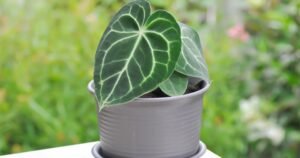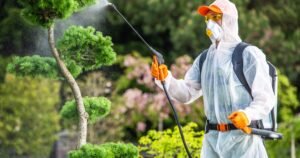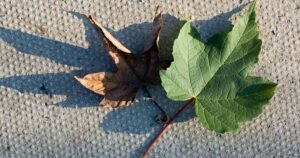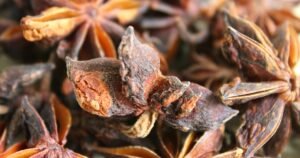How to Attach Air Plants to Driftwood?
Fishing Line:
Attaching air plants to a wreath or driftwood is a breeze with a fishing line, and since it’s transparent, it remains inconspicuous – a definite advantage!
Employ the same technique as you would with wire: thread the fishing line through the plant’s leaves and secure it with a knot.
Air plants, also known as Tillandsia, are unique and fascinating plants that don’t require soil to grow.
They can be attached to various surfaces, including driftwood, creating a visually appealing and natural display.
In this guide, we’ll detail the steps to effectively attach air plants to driftwood, ensuring a secure and aesthetically pleasing arrangement.
Preparing the Driftwood
Before you attach your air plants to the driftwood, it’s critical to prepare the wood properly. Ensure to select a piece of driftwood that complements the size and design of your air plants.
Once you’ve chosen your driftwood, clean it thoroughly to remove any dirt, salt, or living organisms.
You can do this by soaking it in a bucket of water for a couple of days and changing the water daily. After soaking, allow it to dry completely in the sun.
This preparation is essential to create a safe and suitable home for your air plants.
1. Selecting Suitable Driftwood
Start by selecting pieces of driftwood that are clean, dry, and free from any signs of mold or rot.
Look for driftwood with interesting shapes and textures that complement the appearance of air plants.
Ensure the driftwood is sturdy and has ample surface area for attaching the air plants securely.
2. Gathering Necessary Materials
Gather all the materials required for this project.
These typically include air plants (preferably a variety of sizes and types), wire, fishing line, waterproof glue, and a spray bottle filled with room-temperature water for misting.

3. Attaching Air Plants to Driftwood
Once you have gathered all the necessary materials, it’s time to attach your air plants to the driftwood.
If your driftwood piece has natural crevices or holes, these can be excellent spots to place your air plants.
Using waterproof glue, apply a small amount to the base of your air plant and press it onto the desired location on the driftwood.
Hold it in place for a few moments to allow the glue to bond. If the plant doesn’t stick immediately, you can use wire or fishing line to secure the plant until the glue dries completely.
Remember to arrange the air plants in a way that complements the shape of the driftwood and creates a balanced visual aesthetic.
4. Preparing the Air Plants
How to Attach Air Plants to Driftwood? Before attaching the air plants, it’s essential to rehydrate them. Submerge the air plants in room-temperature water for about 1 to 2 hours.
This soaking helps the plants absorb moisture and become plump and healthy, enhancing their ability to attach and thrive.
5. Creating Attachment Points
To create secure attachment points for the air plants, wrap sections of the driftwood with wire. Alternatively, tie knots with fishing lines around the driftwood, forming loops or areas where the air plants can be securely attached.
6. Attaching Air Plants
Place the rehydrated air plants onto the wire-wrapped or knotted areas of the driftwood.
Gently position them to achieve the desired arrangement and aesthetic.
Ensure the air plants are snugly and securely attached to the driftwood, allowing for ample airflow around each plant.

7. Using Glue for Extra Security
For added security, apply a small amount of waterproof glue to the wire or knots where the air plants are attached.
The glue will provide additional stability and ensure the air plants stay in place.
Allow the glue to dry completely before moving or displaying the driftwood.
8. Caring for Driftwood and Air Plants
Place the driftwood with attached air plants in a location with indirect sunlight, as direct sunlight can damage the plants.
Ensure there is good air circulation to prevent moisture buildup.
Regularly mist the air plants using a spray bottle filled with room-temperature water.
Aim to mist them 2 to 3 times a week, adjusting based on the humidity levels in your environment.
Monitor the health of the air plants and make necessary adjustments to their care routine to ensure they thrive in their new driftwood habitat.
By following these steps and providing proper care, you’ll create a stunning and sustainable display of air plants attached to driftwood, enhancing the natural beauty of both the plants and the driftwood.
9. Enjoying Your Driftwood and Air Plant Display
Now that you’ve created your beautiful air plant and driftwood arrangement, it’s time to enjoy it! Display the driftwood in a prominent location where its natural beauty can enhance your living space.
With their minimal care requirements, air plants make for a striking and stress-free addition to your home or office.
Remember, the key to maintaining a thriving air plant display is consistent care and observation.
Enjoy the calming effects and aesthetic appeal of your unique air plant and driftwood display.
10. Troubleshooting Common Issues
In case you notice that your air plants are not thriving on the driftwood, don’t panic. It’s important to identify the issue promptly to restore their health.
If the leaves are turning brown or crispy, your plants may be under-watered.
Increase the frequency of misting and consider soaking them in water for a couple of hours.
If the plants appear overly soggy or are developing a musty smell, they may be getting too much water or insufficient airflow.
Reduce the watering frequency and ensure your display is in a well-ventilated area.
Remember, healthy air plants have firm but flexible leaves and display vibrant colors.
With careful observation and adjustments, you can ensure your air plant and driftwood display remain in excellent condition.
Conclusion
How to Attach Air Plants to Driftwood? Creating a stunning air plant and driftwood display not only brings natural beauty into your space but also offers an engaging and fulfilling DIY project. The process, from selecting the perfect piece of driftwood to attaching the air plants and caring for them, allows you to connect with nature and express your creativity. Troubleshooting any issues that arise can provide valuable insights into the care of these unique plants, enhancing your gardening skills. Remember, the success of your display largely depends on consistent care and observation. With these in place, you’ll have a living piece of art that grows and evolves, offering endless enjoyment and tranquility.
FAQs
How do you stick air plants to driftwood?
To attach air plants to driftwood, use waterproof glue. Apply a small dot of glue to the base of the air plant and press it onto the desired spot on the driftwood.
If necessary, secure the plant with wire or fishing line until the glue dries. Always position the plants to allow for good air circulation, which is crucial for their health and growth.
How do you glue air plants to wood?
To glue air plants to wood, you’ll need waterproof glue. Dab a small amount of glue onto the base of the air plant.
Press the plant onto the wood in your desired location, holding it in place briefly to let the glue take hold.
If it fails to stick immediately, use a wire or fishing line to secure it until the glue fully dries. Remember, air circulation is important for air plants, so position them accordingly.
What glue can you use on air plants?
In the process of affixing air plants to driftwood or any other material, it is essential to use glue that is non-toxic and safe for plants.
An ideal choice for this purpose would be a silicone-based adhesive or a hot glue gun with low-temperature settings.
These adhesives are waterproof and do not harm the plants, ensuring they remain healthy and secure.
What do air plants like to attach to?
Air plants are epiphytes, meaning they naturally grow on another plant or object for support rather than in soil.
They are quite versatile and can attach to a variety of surfaces, including rocks, trees, and even ceramic decorations.
However, they thrive particularly well on materials that allow for good air circulation, such as wood or cork bark.
This makes driftwood an excellent choice for displaying these fascinating plants.











